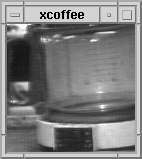Trojan Room coffee maker
The Trojan Room Coffee Pot ( English name Trojan Room coffee machine / pot ) was the motivation for the first webcam . The webcam displayed the level of the coffee machine in the hallway in front of the so-called Trojan Room of the old computer laboratory at the University of Cambridge in a periodically updated 128 × 128 pixel grayscale image and could be viewed via the Internet with a web browser . The webcam was set up to save people in more distant parts of the building unnecessary trips to the possibly empty coffee pot. Since it demonstrated both the meaning and the banality of the new World Wide Web , it quickly gained worldwide popularity in this medium.
Operation of the camera began in 1991 in the local network of the university's computer laboratory using a frame grabber card in an Acorn-Archimedes computer. First, the whole system ran by its own RPC protocol over ATM with a written by Paul Jardetzky server program and written by Quentin Stafford-Fraser client application called XCoffee for on the X Window System -building graphical user interfaces .
When it became possible in 1993 to display images directly on websites , Daniel Gordon and Martyn Johnson were able to simply distribute the periodically updated images from the camera, as no special software was required on the clients and the integrated image file was automatically updated when the website was reloaded overwritten and could therefore be updated very easily. So they overhauled the camera system and connected it to the Internet in November 1993 . In this way, every Internet user could access the camera with their web browser, and the first webcam became a popular starting point in the early World Wide Web.
On August 22, 2001 at 09:54 UTC the camera was switched off and the coffee machine (a model by Krups ) was auctioned on eBay for 3500 pounds sterling to the news platform Spiegel Online . The shutdown has been featured on the front pages of the London Times and Washington Post, as well as articles in The Guardian and Wired . After the Krups coffee machine had been repaired free of charge, the webcam in Spiegel Online's editorial office was put back into operation.
The Trojan Room coffee machine appears in the video game Hitman 2: Silent Assassin , where the player can destroy a "coffee camera" in the kitchen in a mission, and in the Hyper Text Coffee Pot Control Protocol , which is described in April Fool's Day RFC 2324 .
In summer 2016, Spiegel Online made the coffee machine available to the Heinz Nixdorf MuseumsForum in Paderborn as a permanent loan. Since then, the object has been shown in the permanent exhibition.
literature
- The Life and Times of the First Web Cam: When convenience was the mother of the invention . In: Communications of the ACM . Vol. 44, No. 7, July 2001, pp. 25-26.
Web links
- The Trojan Room Coffee Machine by Daniel Gordon & Martyn Johnson onthe University of Cambridge Computer Laboratory website
- Trojan Room Coffee Pot resources , collection of links by Quentin Stafford-Fraser on the Computer Laboratory website
- Trojan machine: The history of the world's most famous coffee machine , link collection on Spiegel Online , March 25, 2002 (with CoffeeCam )
- Link catalog on The Trojan Room Coffee Machine at curlie.org (formerly DMOZ )
- Wired: Spiegel Online sends the world's most famous coffee machine into retirement However, the coffee machine is not on display in the Technikmuseum Berlin, but in the permanent exhibition of the Heinz Nixdorf Museum Forum in Paderborn. HNF: The World on the Net - History of the Internet
- CoffeeCam of the HNF: Live View
- Museum Digital: Object catalog - Krups ProAroma 305 - Trojan Room Coffee Pot - Machine / Trojan Room coffee machine
- World's First Webcam - Computerphile , November 10, 2017.
Footnotes
- ↑ Quentin Stafford-Fraser: The Trojan Room Coffee Pot: A (non-technical) biography . The website Computer Laboratory of the University of Cambridge. May 1995
- ↑ Quentin Stafford-Fraser: The Life and Times of the First Web Cam: When convenience was the mother of the invention . In: Communications of the ACM . Vol. 44, No. 7, July 2001, pp. 25-26.
- ↑ Quentin Stafford-Fraser: Untitled post. In: Status-Q. April 18, 2001, Retrieved January 25, 2016 .
- ↑ The coffee is ready: The comeback of the Trojan Room Coffee Cam . In: Spiegel Online . December 24, 2001
- ^ Permanent exhibition of the Heinz Nixdorf MuseumsForum: The world on the net - The history of the internet.

